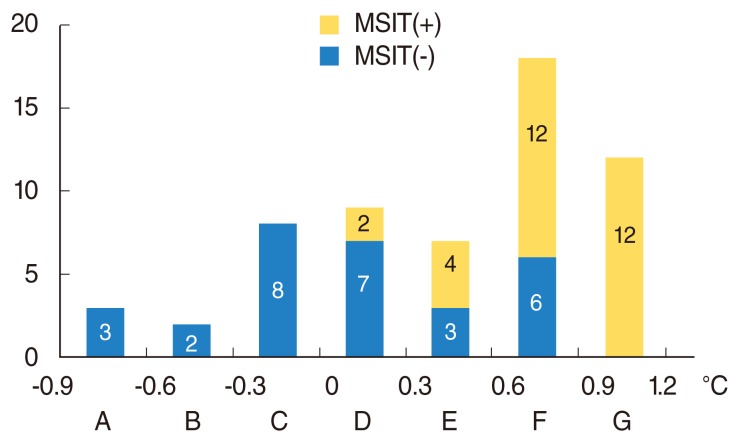Clin Exp Otorhinolaryngol.
2013 Dec;6(4):249-253.
Comparisons of Three Indicators for Frey's Syndrome: Subjective Symptoms, Minor's Starch Iodine Test, and Infrared Thermography
- Affiliations
-
- 1Department of Otorhinolaryngology-Head & Neck Surgery, Hallym University Sacred Heart Hospital, Anyang, Korea. pbj426@hallym.ac.kr
Abstract
OBJECTIVES
To correlate Frey's syndrome with subjective symptoms, Minor's starch iodine test results, and infrared thermography measurements, and to discuss the utility of thermography as a quantitative diagnostic method.
METHODS
This study included 59 patients who underwent unilateral parotidectomy. A subjective clinical questionnaire and an objective Minor's starch iodine test were performed to evaluate the incidence of Frey's syndrome. Infrared thermography was performed, and the subjects were divided into seven groups according to the temperature differences between operated and unoperated sites. The thermal differences were correlated with the results from Minor's starch iodine test and the subjective symptoms questionnaire.
RESULTS
Of the 59 patients, 20 patients (33.9%) reported subjective symptoms after eating; 30 patients (50.8%) tested positive for Minor's starch iodine test, 19 patients (63.3%) of which reported subjective symptoms. Of the 29 patients who were negative for the iodine test, 2 patients (6.9%) reported subjective symptoms. Thus, subjective symptoms were well correlated with Minor's starch iodine test (r=0.589, P<0.001). As the thermal differences with infrared thermography increased, the number of patients with subjective symptoms increased (chi2=22.5, P<0.001). Using infrared thermography, the mean temperature difference in the positive group for the iodine test was 0.82degrees C+/-0.26degrees C, and that in the negative group was 0.10degrees C+/-0.47degrees C. With increased thermal differences, more patients showed positivity in the iodine test (chi2=29.9, P<0.001).
CONCLUSION
Subjective symptoms, Minor's starch iodine test, and infrared thermography are well correlated with one another. Quantitative thermography provides clues for the wide variation in the incidence of Frey's syndrome, and could be a useful method for diagnosing and studying Frey's syndrome.
Keyword
MeSH Terms
Figure
Reference
-
1. Gooden EA, Gullane PJ, Irish J, Katz M, Carroll C. Role of the sternocleidomastoid muscle flap preventing frey's syndrome and maintaining facial contour following superficial parotidectomy. J Otolaryngol. 2001; 4. 30(2):98–101. PMID: 11770964.
Article2. Allison GR, Rappaport I. Prevention of frey's syndrome with superficial musculoaponeurotic system interposition. Am J Surg. 1993; 10. 166(4):407–410. PMID: 8214303.
Article3. Santos RC, Chagas JF, Bezerra TF, Baptistella JE, Pagani MA, Melo AR. Frey syndrome prevalence after partial parotidectomy. Braz J Otorhinolaryngol. 2006; Jan-Feb. 72(1):112–115. PMID: 16917561.
Article4. Owen ER, Banerjee AK, Kissin M, Kark AE. Complications of parotid surgery: the need for selectivity. Br J Surg. 1989; 10. 76(10):1034–1035. PMID: 2597945.
Article5. Sood S, Quraishi MS, Bradley PJ. Frey's syndrome and parotid surgery. Clin Otolaryngol Allied Sci. 1998; 8. 23(4):291–301. PMID: 9762489.
Article6. Isogai N, Kamiishi H. Application of medical thermography to the diagnosis of frey's syndrome. Head Neck. 1997; 3. 19(2):143–147. PMID: 9059873.
Article7. Laage-Hellman JE. Gustatory sweating and flushing after conservative parotidectomy. Acta Otolaryngol. 1957; 9. 48(3):234–252. PMID: 13469322.
Article
- Full Text Links
- Actions
-
Cited
- CITED
-
- Close
- Share
- Similar articles
-
- Effectiveness of Botulinum Toxin A in Treatment of Frey's Syndrome
- Treatment of Frey's Syndrome Patients with Botulimum Toxin A
- The Effectiveness of Sternocleidomastoid Muscle Flap in Preventing Frey's Syndrome Following Parotidectomy
- Comparison of the Clinical Effectiveness Between Infrared Thermography and Electrophysiology Tests in Spinal Intradural Extramedullary Schwannoma
- Application of infrared thermography in dentistry




